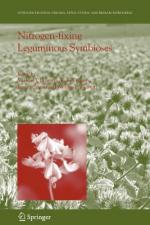|
This section contains 1,419 words (approx. 5 pages at 300 words per page) |

|
Biological nitrogen (N2) fixation is the reduction of atmospheric nitrogen gas to ammonia, according to the equation:
N2+ 10H+ 8 e- 16ATP +2NH4+ + H2 + 16ADP + 16Pi
The reaction is mediated by an oxygen-sensitive enzyme nitrogenase and requires energy, as indicated by the consumption of adenosine triphosphate (ATP). This conversion of inert N2 gas into a form utilized by most organisms is the second most important biological process on Earth after photosynthesis. It contributes 175 million tons of nitrogen per year to the global nitrogen economy and accounts for 65 percent of the nitrogen used in agriculture. In Brazil alone, N2 fixation contributes the equivalent of 2.5 million tons of fertilizer nitrogen annually to agricultural production and is essential to a country with limited natural gas reserves for fertilizer nitrogen production.
This article emphasizes symbiotic N2 fixation in grain and pasture legumes in the family Fabaceae. N2 fixation also...
|
This section contains 1,419 words (approx. 5 pages at 300 words per page) |

|


